Fixing my Posture Fixed my Pain
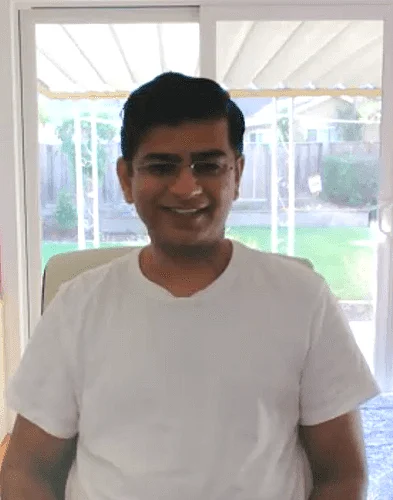
Suffering with back and hip pain, Kapil recalled the upright, elegant posture he had seen in India.
My background and posture in India
I am a 45-year-old software engineer living in California. I grew up and lived in India until I was 37. In my mid-twenties I developed lower back pain and right hip pain, and I recollect having a series of MRIs and medical traction but obtaining nothing more than temporary relief. I also went for Indian massage therapy, which did effectively relieve the pain for some years. Like many modern desk workers, my posture had gradually deteriorated. The massage addressed the symptoms this caused but did not improve my posture.

Here I am 33 years old. I am starting to round my shoulders, sink into my chest and lift my chin.
As Esther often says, older generations, villagers, and the manual workers in India have excellent posture, which includes a J-spine, the head back, and the shoulders back.
I would observe people around me with upright, elegant posture, and could see that it was healthy, but I couldn’t figure out what I should be doing to get there.
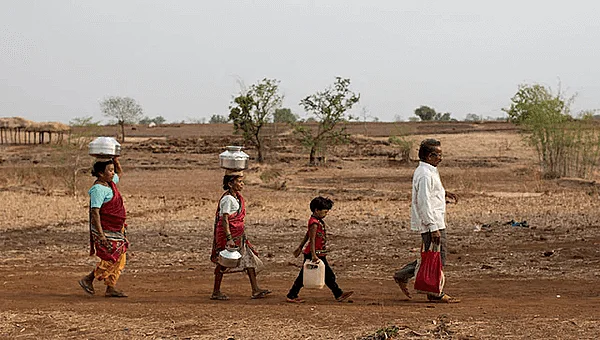
Tall, elegant posture is almost universal among Indian villagers. Firstpost
My father had very good posture and no back pain. I wondered if I had muscle weakness, or if it was just that my body was structured differently.
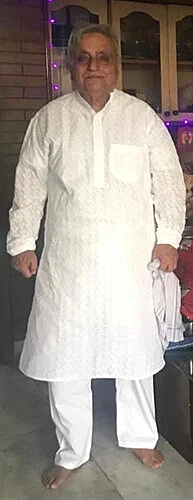
In this photo my father is in his eighties and has preserved his upright bearing. Note that his feet are angled outward due to the external rotation of his legs.
Here in the States, I continued to work with various health practitioners to see what was causing my pain. Some sessions with a chiropractor helped, but the relief, though it sometimes lasted as long as a year, was always temporary. I felt that something I was doing was making the pain reappear.
Getting started with the Gokhale Method®
I found the Gokhale Method through a blogger in the Bay Area, who referred to the Gokhale Method having seen Esther’s presentation at Google. That led me to the concept of postural education. I realized that I needed guidance to restore healthy posture to my body that didn’t know what to do.
Because poor posture is a relatively modern problem, traditional therapies like massage and yoga did not need to address it—and didn’t for me. Even though I grew up in a part of the world where healthy posture was common, I did not know how to integrate it. In many areas humanity has made huge progress, but now, with our posture, we actually need to achieve some healthy regression!
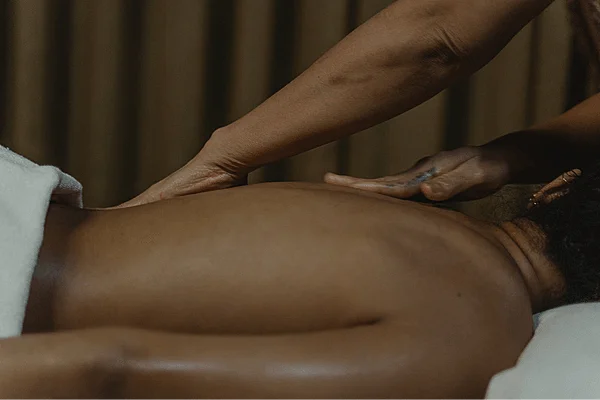
Traditional therapies such as massage may temporarily relieve the symptoms but not the root cause of back pain. Pexels
I read Esther’s book, realized I needed a teacher and decided to take an Initial Online Consultation. It became clear my posture could be changed. I chose to take the 18-lesson Elements online course over about six weeks in the autumn.
Becoming pain-free and making further progress
The earlier lessons were quite easy because each lesson focused on just one thing, so I had time to practice and adapt. They nevertheless had already helped to decrease my pain by the time we came to the later lessons. The later lessons needed finesse to coordinate everything that had been learned. Walking was the most challenging, with so many parts to consider at once.
The course is well paced and structured, using intelligently designed stepping stones. I could see how the lessons fit together. Reflecting back, if we had started with the later material, it would have been a daunting task.
When we got to the walking lessons, I thought about asking to spread the lessons out more, but I now recognize that the momentum of our regular schedule was important. Mastery was not expected, and I needed that additional input and tips to continue making progress. There is a saying, “without the guru I cannot gain knowledge” and I found this to be true both for the content and the teaching method.
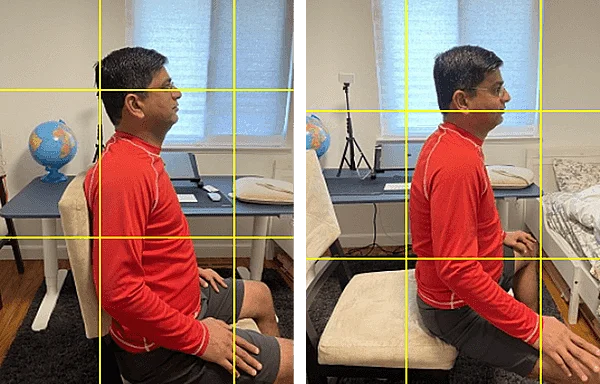
My “Before” pictures as I embarked on the Elements course. I was trying to implement a few principles I read about in 8 Steps to a Pain-Free Back. I still had a long way to go.
I have learned to focus on one posture tip at a time, and cycle through them to keep improving on everything I do, whether it is bending or sitting well. Ongoing practice, rewatching course videos, and referring to photographs all help keep things on my radar, reinforce good habits, and create muscle memory over time.
An active lifestyle is not enough
I have always led an active life—I played racquetball at least twice or thrice a week, I did yoga almost every day, I gardened once or twice a week, and I walked (and still do, almost every day). On reflection I can see that all this exercise, without paying attention to my posture, did not prevent my back and hip pain.
I wouldn’t be able to garden for more than 30 minutes if I hadn’t learned to hip-hinge. My pain would come back. Agricultural workers in India can work eight hours a day, day after day—because they hip-hinge! It is fascinating to see Esther point out this type of bending, in photographs and in ancient art.
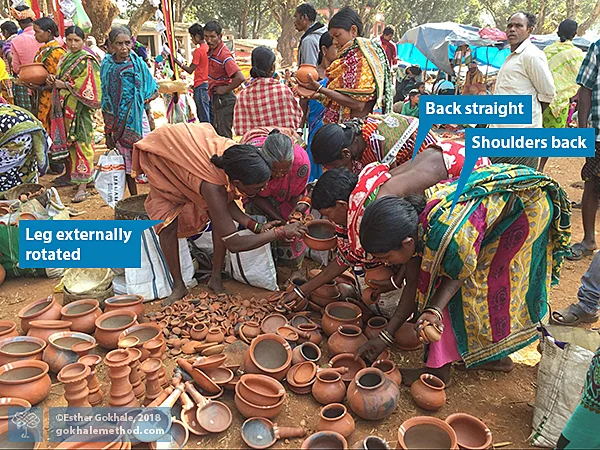
Women hip-hinge with ease at a market in Odisha, India, while they examine pots.
I can see that some of our modern occupational hazards arise from sedentary work—so I have always been very careful to not sit for a long duration, switching places each hour. Yet, if I don’t roll back my shoulders, glide my head back, and take care of my rib anchor, none of that matters—I would still have pain. Taking breaks is helpful, but it’s not enough. Posture is a fundamental thing that needs to be taken care of too.
Going forward
I am aware that I have taken Elements only recently and still have a way to go, but the posture that I have learned to recreate in my body has not only stopped my pain, but also feels very natural to me—my neck being tall and my head staying back as I sit at my desk, for example. I would still like to use the PostureTracker™ biofeedback tool that can help me to track my progress and monitor my posture adjustments in real time.
I paused my yoga regime while I was taking Elements in case there was anything I was doing that was contrary to a new way of doing things. Esther then showed me a new way of doing sun salutation which I look forward to resuming shortly. When I learned to improve my posture I made no other lifestyle changes, so I have good reason to believe posture has addressed the root causes of my pain and will be sustainable.
I would have had many years of a pain-free life behind me if I had made these changes earlier—however, better late than never! I am very fortunate to have found something that has made such a difference to my life.
I have a lot of respect and enthusiasm for the Gokhale Method, and my motivation with this blog post is to spread the word about it. Please share my story to inspire others who suffer unnecessarily with back pain.
Free Online Workshops
If you would like to find out more about how the Gokhale Method can help support you, whether you have back pain or other musculoskeletal pain, sign up to join one of Esther’s upcoming FREE Online Workshops.

Comments
Thank you for taking the time
Thank you for taking the time to write this. I am glad that this method has helped you. You mentioned that it would have been good to have found out about this earlier and I agree with you. I am 69 now and have suffered for years and only heard about this method last year.
When working with Esther on Zoom I used to be holding my hands under the table to try to bear my pain. I have moved on considerably and still have a long way to go but I am moving forward, now with Clare Chapmans's help. I am in mostly out of pain and it is now just triggered by something I do but I am getting there by practicing hip hinging etc.
It is so good to read your story.
Add New Comment
Login to add commment
Login